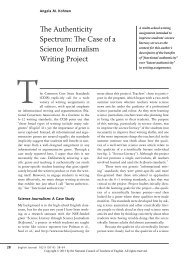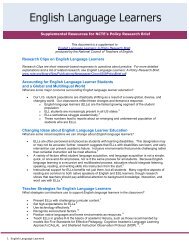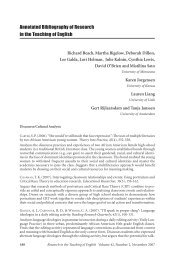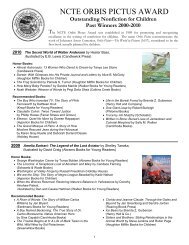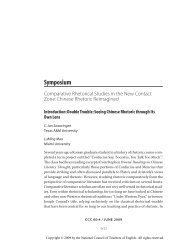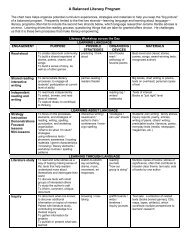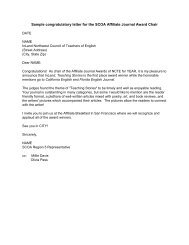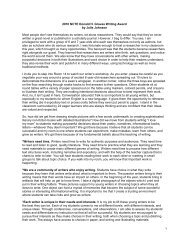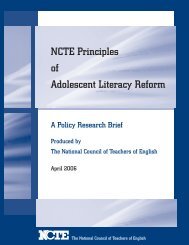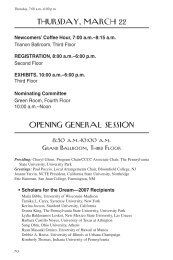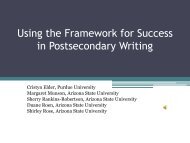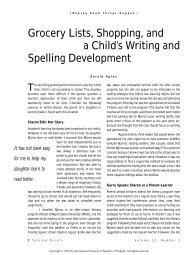<strong>Annotated</strong> <strong>Bibliography</strong> 215KATZIR, T., KIM, Y. S., WOLF, M., KENNEDY, B., LOVETT, M., & MORRIS, R. (2006). The relationship <strong>of</strong>spell<strong>in</strong>g recognition, RAN, and phonological awareness to read<strong>in</strong>g skills <strong>in</strong> older poor readersand younger read<strong>in</strong>g-matched controls. Read<strong>in</strong>g and Writ<strong>in</strong>g, DOI 10.1007/s11145-006-9013-2.KUCER, S. B., & SILVA, C. (2006). Teach<strong>in</strong>g <strong>the</strong> dimensions <strong>of</strong> literacy. Mahwah, NJ: Erlbaum.LI, G. (2005). Culturally contested pedagogy: Battles <strong>of</strong> literacy and school<strong>in</strong>g between ma<strong>in</strong>streamteachers and Asian immigrant parents. Albany: SUNY Press.LUCKER, J. L., SEBALD, A. M., & COONEY, J. (2005/2006). An exam<strong>in</strong>ation <strong>of</strong> <strong>the</strong> evidence-basedliteracy research <strong>in</strong> deaf education. American Annals <strong>of</strong> <strong>the</strong> Deaf, 150(5), 443-456.LYSAKER, J. T. (2006). Young children’s read<strong>in</strong>gs <strong>of</strong> wordless picture books: What’s “self” got to dowith it? Journal <strong>of</strong> Early Childhood Literacy, 6(1), 33-55.MALLETTE, M. H., HENK, W. A., & WAGGONER, J. E. (2005). What matters most? A survey <strong>of</strong> accomplishedmiddle-level educators’ beliefs and values about literacy. Action <strong>in</strong> Teacher Education,27(2), 33-42.MARSH, J., & MILLARD, E. (EDS.). (2006). Popular literacies, childhood and school<strong>in</strong>g. New York:Routledge.MARTINS, M. A., & SILVA, C. (2006). The impact <strong>of</strong> <strong>in</strong>vented spell<strong>in</strong>g on phonemic awareness.Learn<strong>in</strong>g and Instruction, 16(1), 41-56.MCKEOUGH, A., LUPART, J. L., PHILLIPS, L. M., & TIMMONS, V. (EDS.). (2006). Understand<strong>in</strong>g literacydevelopment: A global view. Mahwah, NJ: Erlbaum.NATIONAL RESEARCH COUNCIL. (2005). Measur<strong>in</strong>g literacy: Performance levels for adults. Wash<strong>in</strong>gton,DC: National Academies Press.NUTBROWN, C., HANNON, P., & MORGAN, A. (2005). Early literacy work with families: Policy, practiceand research. Thousand Oaks, CA: SAGE.PAHL, K., & ROWSELL, J. (EDS.). (2006). Travel notes from <strong>the</strong> new literacy studies: Instances <strong>of</strong>practice. Clevedon, UK: Multil<strong>in</strong>gual Matters Limited.PAN-AFRICAN READING FOR ALL CONFERENCE. (2005). Literacy for all <strong>in</strong> Africa. Kampala, Ugandaand Newark, DE: Founta<strong>in</strong> Publishers and International Read<strong>in</strong>g Association.PASA, L. (2005). Educational <strong>in</strong>fluence on read<strong>in</strong>g and spell<strong>in</strong>g: A comparative study <strong>of</strong> threeFrench first-grade classes. L1 – Educational Studies <strong>in</strong> Language and Literature, 5(3), 403-415.PECK, S. M., & VIRKLER, A. J. (2006). Read<strong>in</strong>g <strong>in</strong> <strong>the</strong> shadows: Extend<strong>in</strong>g literacy skills throughshadow-puppet <strong>the</strong>ater. The Read<strong>in</strong>g Teacher, 59(8), 786-795.PEXMAN, P. M., GLENWRIGHT, M., KROL, A., & JAMES, T. (2005). An acquired taste: Children’s perceptions<strong>of</strong> humor and teas<strong>in</strong>g <strong>in</strong> verbal irony. Discourse Processes, 40(3), 259-288.POWELL, R., MCINTYRE, E., & RIGHTMYER, E. (2006). Johnny won’t read, and Susie won’t ei<strong>the</strong>r:Read<strong>in</strong>g <strong>in</strong>struction and student resistance. Journal <strong>of</strong> Early Childhood Literacy, 6(1), 5-31.PURCELL-GATES, V., JACOBSON, E., & DEGENER, S. (2006). Pr<strong>in</strong>t literacy development: Unit<strong>in</strong>g cognitiveand social practice <strong>the</strong>ories. Cambridge, MA: Harvard University Press.SANFORD, K. (2006). Gendered literacy experiences: The effects <strong>of</strong> expectation and opportunityfor boys’ and girls’ learn<strong>in</strong>g. Journal <strong>of</strong> Adolescent and Adult Literacy, 49(4), 302-315.SMITH, D., & WHITMORE, K. F. (2005). Literacy and advocacy <strong>in</strong> adolescent family, gang, school, andjuvenile court communities: Crip 4 life. Mahwah, NJ: Erlbaum.SOHN, K. K. (2006). Whistl<strong>in</strong>’ and crow<strong>in</strong>’ women <strong>of</strong> Appalachia: Literacy practices s<strong>in</strong>ce college.Carbondale: Sou<strong>the</strong>rn Ill<strong>in</strong>ois University Press.SALOMON, F., & APAZA, E. (2006). Vernacular literacy on <strong>the</strong> Lake Titicaca High Pla<strong>in</strong>s, Peru.Read<strong>in</strong>g <strong>Research</strong> Quarterly, 41(3), 304-326.STONE, C. A., EHREN, B. J., SILLIMAN, E. R., & APEL, K. (EDS.). (2005). Handbook <strong>of</strong> language andliteracy: Development and disorders. New York: Guilford Press.
216 <strong>Research</strong> <strong>in</strong> <strong>the</strong> Teach<strong>in</strong>g <strong>of</strong> <strong>English</strong> Volume 41 November 2006ST. PIERRE, R. G., RICCIUTI, A. E., & RIIHDZIUS, T. A. (2005). Effects <strong>of</strong> a family literacy program onlow-literate children and <strong>the</strong>ir parents: F<strong>in</strong>d<strong>in</strong>gs from an evaluation <strong>of</strong> <strong>the</strong> Even Start familyliteracy program. Developmental Psychology, 41(6), 953-970.STREET, B. (ED.). (2005). Literacies across educational contexts: Mediat<strong>in</strong>g learn<strong>in</strong>g and teach<strong>in</strong>g.Philadelphia: Caslon.THESEN, L., & VAN PLETZEN, E. (2006). Academic literacy and <strong>the</strong> languages <strong>of</strong> change. London:Cont<strong>in</strong>uum.WAGNER, D. A. (ED.). (2005). Adult literacy research and development: Assessment, learn<strong>in</strong>g and<strong>in</strong>struction. Cresskill, NJ: Hampton Press.VANDERSTAAY, S. L. (2006). Learn<strong>in</strong>g from longitud<strong>in</strong>al research <strong>in</strong> crim<strong>in</strong>ology and <strong>the</strong> healthsciences. Read<strong>in</strong>g <strong>Research</strong> Quarterly, 41(3), 328-350.WASIK, B. A., BOND, M. A., & HINDMAN, A. (2006). The effects <strong>of</strong> a language and literacy <strong>in</strong>terventionon Head Start children and teachers. Journal <strong>of</strong> Educational Psychology, 98(1), 63-74.WEIGEL, D. J., MARTIN, S. S., & BENNETT, K. K. (2006). Contributions <strong>of</strong> <strong>the</strong> home literacy environmentto preschool-aged children’s emerg<strong>in</strong>g literacy and language skills. Early Child Developmentand Care, 176(3-4), 357-378.WILSON, G. L., & MICHAELS, C. A. (2005). General and special education students’ perceptions <strong>of</strong>co-teach<strong>in</strong>g: Implications for secondary-level literacy <strong>in</strong>struction. Read<strong>in</strong>g & Writ<strong>in</strong>g Quarterly,22(3), 205-225.YANNICOPOULOU, A. (2006). The <strong>in</strong>fluence <strong>of</strong> environmental pr<strong>in</strong>t on preschoolers’ literacy development<strong>in</strong> a two-alphabet society. L1 – Educational Studies <strong>in</strong> Language and Literature, 6(1),1-12.Literary Response/LiteratureARYA, P., MARTENS, P., WILSON, G. P., ALTWERGER, L. J., LASTER, B., & LANG, D. (2005). Reclaim<strong>in</strong>gliteracy <strong>in</strong>struction: Evidence <strong>in</strong> support <strong>of</strong> literature-based programs. Language Arts, 83(1),63-72.Investigates whe<strong>the</strong>r commercial phonics-based programs were more effective than literaturebasedprograms <strong>in</strong> develop<strong>in</strong>g 100 students’ read<strong>in</strong>g and read<strong>in</strong>g strategies <strong>in</strong> four 2nd gradeclassrooms. Students <strong>in</strong> each classroom (two phonics-based and two literature-based) read aloudand retold leveled stories that were challeng<strong>in</strong>g but not frustrat<strong>in</strong>g. The researchers followedstandard miscue analysis procedures, and followed with both unaided and aided retell<strong>in</strong>g. Allstudents were also given a standardized phonics test. Data were analyzed accord<strong>in</strong>g to <strong>the</strong> type<strong>of</strong> language cues <strong>the</strong> children used (graphophonic, syntactic, semantic) and <strong>the</strong>ir comprehension.Analysis revealed a decided advantage for <strong>the</strong> students <strong>in</strong> literature-based classrooms whonot only exhibited <strong>the</strong> ability to use phonics to decode, but also to use semantic and syntacticcues to self-correct, thus <strong>in</strong>creas<strong>in</strong>g <strong>the</strong> likelihood <strong>of</strong> comprehension.BROOKS, W. (2006). Read<strong>in</strong>g representations <strong>of</strong> <strong>the</strong>mselves: Urban youth use culture and AfricanAmerican textual features to develop literary understand<strong>in</strong>gs. Read<strong>in</strong>g <strong>Research</strong> Quarterly, 41(3),372-392.Analyzes a group <strong>of</strong> largely African-American middle-school students’ discussion responses toidentified textual/literary features <strong>of</strong> three “culturally conscious” African American children’sbooks. Identifies <strong>the</strong> recurr<strong>in</strong>g cultural <strong>the</strong>mes <strong>of</strong> forg<strong>in</strong>g family and friend relationships, confront<strong>in</strong>gand overcom<strong>in</strong>g racism, and surviv<strong>in</strong>g city life. Categorizes responses based on 13categories related to application <strong>of</strong> cultural knowledge and literary understand<strong>in</strong>g (for example,uncover<strong>in</strong>g motives, affirm<strong>in</strong>g or oppos<strong>in</strong>g choices, dist<strong>in</strong>guish<strong>in</strong>g viewpo<strong>in</strong>ts, and scrut<strong>in</strong>iz<strong>in</strong>gdepictions). F<strong>in</strong>ds a high level <strong>of</strong> engagement with <strong>the</strong> <strong>the</strong>me <strong>of</strong> beliefs <strong>in</strong> <strong>the</strong> supernaturalas well as evidence <strong>of</strong> code-switch from AAVE to Standard <strong>English</strong> <strong>in</strong> written literary responses.Suggests <strong>the</strong> value <strong>of</strong> focus<strong>in</strong>g on recurr<strong>in</strong>g cultural <strong>the</strong>mes <strong>in</strong> teach<strong>in</strong>g multicultural literature.



